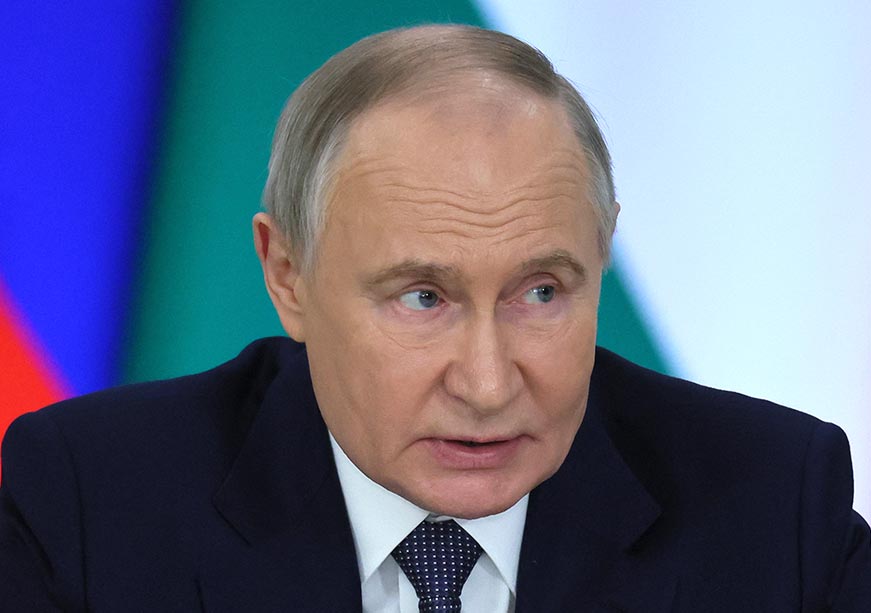-
CENTRES
Progammes & Centres
Location
While Moscow's core demands remain unchanged, its secondary demands have evolved. Among other things, it no longer objects to Ukraine joining the EU.

Image Source: Getty
With growing interest in a peaceful resolution to the war in Ukraine, especially in light of proposals emanating for a partial ceasefire from the West, the conflict appears to be entering a new phase. This is further highlighted by the two-hour phone call on March 18 between Russian President Vladimir Putin and US President Donald Trump, during which they discussed the possible roadmap for ending hostilities. Despite the optimism that the war would likely end on its terms, Moscow is treading cautiously.
Russia has reiterated its commitment to bringing lasting peace to the war, all while its stance remains unchanged since the conflict first began in 2022. Despite the growing interest, the road to bringing lasting peace is mired with its complexities, as there is a fundamental contradiction in the perception(s) of sovereignty and regional security. With an added variable of the improved diplomatic communication between Russia and the US, it will be interesting to chart the future trajectory of the conflict and, more importantly, make sense of Moscow’s understanding of an endgame.
The US stance on the conflict has pivoted from backing Ukrainian claims to now conditionally accepting some of Russia’s demands.
Since the talks began in Saudi Arabia in February, the specifics of an endgame are becoming more apparent. The US stance on the conflict has pivoted from backing Ukrainian claims to now conditionally accepting some of Russia’s demands. These demands include Ukraine ceding the territories of Donetsk, Lugansk, Kherson, and Zaporizhzhia to Moscow, the absence of European troops in Ukraine and Kyiv maintaining neutrality by giving up its claims to join NATO. Ukraine, on the other hand, wants iron-clad security guarantees in the event of another wave of Russian invasion, which crosses Russia’s redlines as it would be used as a pretext for the militarisation of Europe, exacerbating the threat perceptions for Moscow.
In Russia’s calculus, a simple ceasefire would not address Russia’s concerns in European security architecture. In the past, collective efforts to bring peace in Ukraine, such as the Minsk 1 and Minsk 2 agreements, which had the backing of the UN, were not followed through; thus, following the negotiations on March 11 in Riyadh, Kyiv agreed to the US proposals for a 30-day ceasefire. Moscow agreed in principle to these demands while reiterating that the root cause of the conflict had to be eliminated.
Furthermore, the ceasefire would impact the battlefield tempo of the Russian armed forces, who have made considerable gains since February 2024 with the capture of Avdiivka in the Donetsk region. Russia currently claims to hold more than 99 per cent of Lugansk, 75 per cent of Donetsk, Kherson, and Zaporizhzhia. For Moscow, the ceasefire will give Ukraine ample time to consolidate its resources and launch a counter-attack against Russia. Further, Russia did not want Ukraine to use the territory it captured in Kursk as leverage in the peace talks, which is why the Russian armed forces intensified their operations to reclaim lost territory in the Kursk Oblast.
Lastly, freezing the conflict along the current lines and enforcing it would be a herculean task; the 970 km frontline would require more than 83,000 peacekeepers to be deployed to secure the demilitarised zone. Further, there are questions about who would fund the peacekeeping force, further complicating the arrival of any potential agreement.
During Putin’s second phone conversation with Trump, the Russian president agreed to both nations refraining from attacking each other’s energy infrastructure for 30 days, a moratorium on striking military and civilian ships, and exchange of prisoners of war. Putin further called for the suspension of military aid to Ukraine. Following the phone call with Putin, Trump spoke to Ukrainian President Zelenskyy the following day. Moscow’s tone reflects a phased de-escalation of the war in Ukraine; however, its key concerns remain unchanged.
Russia’s rigid stance reflects its perceived leverage in the conflict, but sanctions are a key factor that could force significant concessions.
The ceasing of attacks on energy infrastructure is not a new development; before Ukraine’s incursion into Kursk last year, preliminary talks were underway to conduct negotiations on ceasing such attacks. The present ceasefire has more tangible benefits for Moscow than Ukraine. Following the phone call, oil prices stabilised, as the production volumes and supply will likely remain stable because of the absence of geopolitical risks.
Russia’s rigid stance reflects its perceived leverage in the conflict, but sanctions are a key factor that could force significant concessions. Since 2014, over 25,595 sanctions have been imposed on Russia, impacting its economy despite building resilience against sanctions. With more than 45 per cent of Russia’s revenue tied to energy exports and the EU reducing its oil and gas consumption, Russia seeks the return of Western businesses. However, economic recovery will be challenging, as US sanctions require Congressional approval and the EU will not lift sanctions that oppose Ukraine’s interests.
In the game of phased de-escalation, Moscow seeks to avoid being perceived as unwilling to negotiate, as this could be seen as a failure for Russia. This explains the nuances in Russia’s positions — while its core demands remain unchanged, its secondary demands have evolved. For example, one of the key drivers of the Ukraine crisis in 2014 was Ukraine’s aspiration to join the European Union. However, today, Russia has shown acceptance of Ukraine’s potential EU membership.
The path to peace remains long, with extended negotiations ahead. Progress is likely to be incremental, shaped by the realistic demands of the involved parties, as no one benefits from the failure of the peace process. However, if negotiations collapse due to Russia’s refusal to engage, a walkout would likely prompt the US to intensify its support for Ukraine, prolonging the war.
This commentary originally appeared in The Indian Express.
The views expressed above belong to the author(s). ORF research and analyses now available on Telegram! Click here to access our curated content — blogs, longforms and interviews.

Rajoli Siddharth Jayaprakash is a Research Assistant with the ORF Strategic Studies programme, focusing on Russia's domestic politics and economy, Russia's grand strategy, and India-Russia ...
Read More +